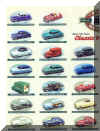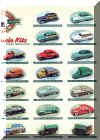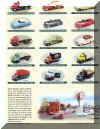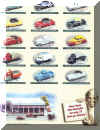On-line since 2002
> 600
pages
> 1150 manufacturers
> 11000
pictures
> 1.000.000 unique visitors
87thScale.info does not
spam. If you received a
spam message with an 87thScale return mail
address it is forged.
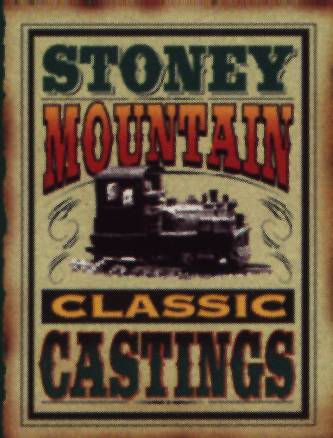
This US based company produced models in kit-form in solid cast resin. Apart from these, SMCC also did a limited number (around 100) of finished models complete with a clear plastic box with labels.
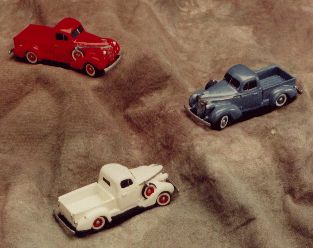
Information taken from the 'about' page on the SMCC website on 12-12-1998:
| Stoney Mountain Classic Castings is proud
to introduce its' catalog to the world of minatures and model railroad
enthusiasts. The products contained within our catalog are just the
start of an evergrowing line of castings and accessories from Stoney
Mountain Classic Castings. Stoney Mountain Classic Castings has put together a team of professional designers and modelers in creating our unique product line. Combined we have over 35 years experience in the developement of minatures and model railroading. This added to over four generations of mold making and casting experience, gives Stoney Mountain Classic Castings the ability to create the most intricate and detailed products available in todays market. Stoney Mountain Classic Castings is dedicated to ensure that each of its' handcrafted products is thoroughly inspected for flaws and defects prior to being packaged and shipped. This enables the minature or model railroading enthusiast to be able to add any one of our products to their layout/setup with minimal touch-up or work. Like our motto states: We've done the hard part so that you can do the fun part!!! Stoney Mountain Classic Castings welcomes any comments or inquiries, so please feel free to contact us! |
Background information on SMCC as
told to 87thScale.info by Lee Nehlsen on August 6th, 2003:
(Lee Nehlsen was one of the four partners in Stoney Mountain Classic Castings.
When he left SMCC about four years ago,
production stopped since he was doing all the casting, packing and
shipping)
|
SMCC was started in the early 90's by
Roger and Lindy. They built small dioramas using the type of detail
you see on the FSM layout and sold them at train shows including GATS.
At that time I was a partner in a hobby shop in Montrose, California.
I met Roger and Lindy at a GATS show and found out they were buying
all their material at retail prices and I offered to give them a
discount if they came to my shop.
The next step was when Woodland Scenics came out with the rubber molds for casting rocks with hydrocal plaster. We spent a whole day learning ways to cast with hydrocal. Roger made a number of dioramas using the rocks. He had made a couple of small layouts with a mining theme and the last one was using HOe and was about two by three feet. Enter the brothers, Hal and Doug, who owned a casting company that made full size castings for buildings. They looked at Roger's layout and said they could make a mold of it and reproduce copies. That became SMCC #1. The rubber mold ruined the original layout so it was cut up and parts were molded to make mini dioramas.
Jerry was coming into the hobby shop as a
customer and we became good friends. He would bring in things he made
including automobiles. I then took him out to see what Roger, Lindy,
Hal and Doug were doing. We tried molding and casting a car in
hydrocal but were not happy with it. Then we tried resin and liked it
better but it needed a lot of work. First we learned to vacuum the
rubber for the mold getting all the air out of it making it silky
smooth. After mixing the resin and filling the molds we would first
vacuum down to about 22 lbs and then put the mold in a pressure pot
taking it up to around 60 lbs. This would first pull all the air out
of the resin and then pack it in tight in the mold.
Hal and Doug broke off from Roger and Lindy keeping the name of 'Stoney Mountain' and added 'Classic Castings'. First we worked in Hal's garage and then we moved to where their business was. Hal and Doug were offered very good jobs in Los Vegas so the company moved to Nevada. After a couple of months I moved too because they did not have time to run the business but after five months, I left because I could not take the heat.
Making the cars was a trial and error
learning process. Jerry did all the originals in clay without any
trim. We would then mold them and cast about a dozen and give these
back to him. He then added the trim using brass. He would also
cut and build making two doors, four doors, station wagons,
convertibles etc. Once we had the front and back, the rest was easy.
When he had finished the model, he would give them a glossy clear
finish and send them back for final molding. The Studebaker pickup is
probably the best we did.
The one thing we could never figure out
was how to make hollow castings. We have seen some very nice hollow
castings in resin and have decided that is the way we want to go next.
What we need is someone who knows how the make hollow castings AND
uses both the vacuum and pressure method. If and when we get it
together, you will see some really great models.
Lee
|
We have listed what we have found sofar, but
since it was possible to get any combination of parts as long as you asked it is
more then likely that other variations exist. The missing names for the numbers with question marks are probably various versions of
the truck models. Lee told us that there were three cabs (Reo, Ford and GMC)
with three different chassis types (tractor 2-axle/3-axle, short and long bed)
and five body styles (box with open back, solid box, refrigirated box, dump, and
both long and short flatbed. Apart from all these possible combinations, the
cabs and chassis were also being sold without bodies.
|
Ref# |
Model | Prototype year |
| SMC-601 | Buick Roadmaster Sedan | 1947 |
| SMC-602 | Buick Roadmaster Open Convertible Top Down | 1947 |
| SMC-603 | Buick Roadmaster Station-Wagon | 1947 |
| SMC-604 | Buick Roadmaster Sedanet | 1947 |
| SMC-605 | Buick Super Sedanet 3 passenger | 1950 |
| SMC-606 | Buick Super Sedanet 5 passenger | 1950 |
| SMC-607 | Buick Super Station-Wagon | 1950 |
| SMC-608 | Buick Roadmaster Station-Wagon | 1950 |
| SMC-609 | Buick Roadmaster Sedan | 1950 |
| SMC-610 | Chevrolet Panel Truck | 1936 |
| SMC-611 | Chevrolet Sedan Delivery | 1936 |
| SMC-612 | Chevrolet 3-axle 1-1/2 Ton Flatbed Truck | 1950 |
| SMC-613 | Chevrolet Aerostar | 1947 |
| SMC-614 | Nash Ambassador 4 doors | 1950 |
| SMC-615 | Nash Ambassador 2 door | 1950 |
| SMC-616 | Nash Ambassador 4 doors | 1951 |
| SMC-617 | Chevrolet Suburban | 1950 |
| SMC-618 | Chevrolet Panel Truck | 1950 |
| SMC-619A | Reo CC 3-axle 1.5-Ton w/Flatbed | 1951 |
| SMC-619B | Reo CC 3-axle 1.5-Ton w/Van Body | 1951 |
| SMC-620 | Dodge CC 1-Ton 2-axle w/Flatbed | 1942 |
| SMC-621 | Packard 4 doors Sedan | 1950 |
| SMC-622 | Packard Woody Station-Wagon | 1950 |
| SMC-623 | Packard Club Sedan | 1950 |
| SMC-624 | Packard 4 doors Sedan | 1948 |
| SMC-625 | Buick Utility Coupe | 1942 |
| SMC-626 | Mercury Woody Station-Wagon | 1949 |
| SMC-627 | Packard Open Convertible | 1950 |
| SMC-628 | Nash Ambassador 2 doors | 1951 |
| SMC-629 | Chevrolet Pick-up | 1941 |
| SMC-630 | Chevrolet Deluxe 2 doors Coupe | 1941 |
| SMC-631 | Kaiser Frazer 4 doors Sedan | 1947 |
| SMC-632 | Packard Limousine | 1948 |
| SMC-633 | Oldsmobile 4 doors Sedan | 1941 |
| SMC-634 | Ford Woody Station-Wagon | 1952 |
| SMC-635 | GMC CO 2-axle w/Box van Body | 1938 |
| SMC-636 | GMC CO 2-axle Flatbed Truck | 1938 |
| SMC-637 | Ford Woody Station-Wagon | 1951 |
| SMC-638 | Ford Station-Wagon | 1952 |
| SMC-639 | Ford Courier Delivery | 1952 |
| SMC-640 | Ford 4 doors Sedan | 1952 |
| SMC-641 | Ford 2 doors Coupe | 1952 |
| SMC-642A | Ford Convertible top-up | 1952 |
| SMC-642B | Ford Open Convertible | 1952 |
| SMC-642C | Ford Open Convertible with continental spare | 1952 |
| SMC-642D | Ford Convertible top-up with continental spare | 1952 |
| SMC-643A | Ford Hardtop | 1952 |
| SMC-643B | Ford Hardtop with continental spare | 1952 |
| SMC-644 | GMC CO 2-axle Cab & Chassis | 1938 |
| SMC-645 | Chevrolet Delivery Panel | 1941 |
| SMC-646 | Chevrolet 4 doors Sedan | 1941 |
| SMC-647 | Chevrolet Convertible Top Up | 1941 |
| SMC-648 | Chevrolet Sedan 2 doors | 1941 |
| SMC-649 | Chevrolet Taxi 4 doors | 1941 |
| SMC-650 | Ford CO 2-axle 134" Chassis | 1948-50 |
| SMC-651 | Ford CO 2-axle w/12' Rib Van | 1948-50 |
| SMC-652A | Ford CO 2-axle w/12' Flatbed | 1948-50 |
| SMC-652B | Ford CO 2-axle w/14' Flatbed | 1948-50 |
| SMC-653 | ? | - |
| SMC-654 | Ford CO 2-axle w/12' Reefer Van | 1948-50 |
| SMC-655 | Ford CO 2-axle 158" Chassis | 1948-50 |
| SMC-656 | Ford CO 2-axle w/14' Van Body | 1948-50 |
| SMC-657 | ? | - |
| SMC-658 | Ford CO 2-axle Tractor | 1948-50 |
| SMC-659 | ? | - |
| SMC-660 | ? | - |
| SMC-661 | Ford CO 2-axle w/Dump Body | 1948-50 |
| SMC-662 | GMC CO 2-axle with Dump Body | 1938 |
| SMC-663 | ? | - |
| SMC-664 | ? | - |
| SMC-665 | ? | - |
| SMC-666 | ? | - |
| SMC-667 | Studebaker Pick-up | 1937 |
| SMC-668 | ? | - |
| SMC-669 | ? | - |
| SMC-670 | ? | - |
| SMC-671 | Buick Riviera Convertible Coupe Top Up | 1950 |
Stoney Mountain catalogue scan:(the 4 pieces make one big poster).
'Jerry's closet'
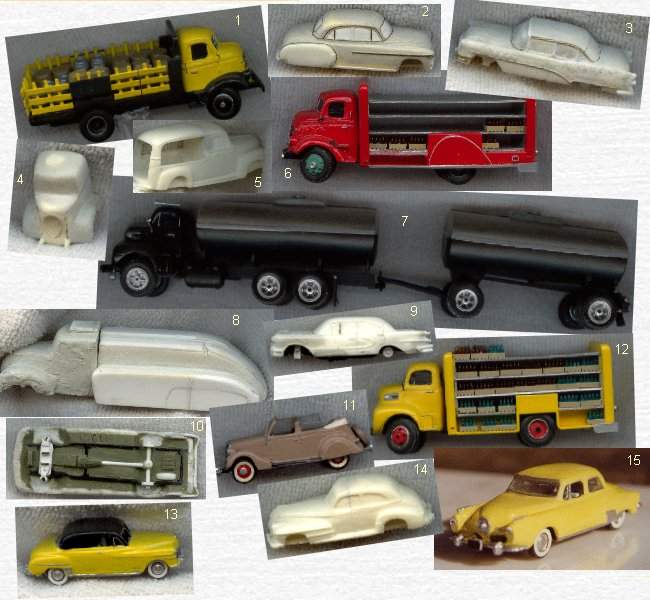
Pictured above are models built in 1/87 scale by Jerry, who did most of the vehicles for Stoney Mountain.
Lee Nehlsen made the pictures and gave us a general description of the models:
'There are six vehicles that were in the process of being made and never finished. The carved out panel
(5) was going to be a street vending produce truck. Another was going to be a Ford cabover with the oval grill out of the
1930's (4). There are a couple of Chevies out of the 1940's (2, 14), one has the brass trim
(2) and is about ready to mold. Another is an artdeco tanker (8) still in the rough. And then there is the
Oldsmobile (3). These, along with other were in the works when SMCC stopped. We are looking to start up again someday under a different name.
The next pictures show the latest
model (9, 10). Note the brake drum on the rear axle and the front axle made for positioning the front wheel. This is the first time that the under carrage is being done and would take a two part mold. The green is modeling clay.
The other shots are finished coke trucks using the SMCC truck cab with new
bodies (1, 6, 12). These also were going to be put into production. But....
Then there is the California tanker (7) that was in the works. Boley beat us to it and did a great job of it.
Last but not least there are some models that Jerry did by modifing someone elses
kit (11, 13, 15). The Studebaker (15) is an Alloy Forms model redone in all metal - never again. There are easier ways.'
![]() Larger
pictures of the trucks in pictures 1, 6, 7 and 12 can be found in Showcase
#10.
Larger
pictures of the trucks in pictures 1, 6, 7 and 12 can be found in Showcase
#10.
Back to the manufacturers list Back to the modellistings page

